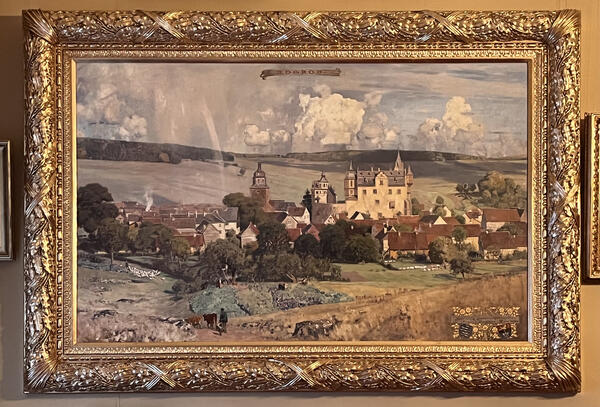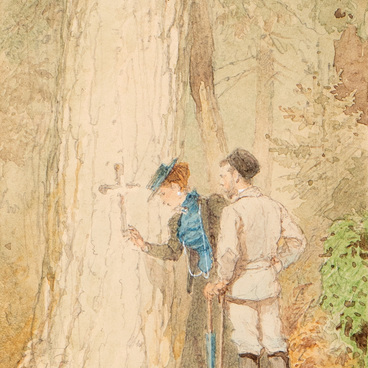The painting “View of Romrod Castle” by the German landscape painter Eugen Bracht adorned the Palisander Drawing Room of the Alexander Palace, which was a kind of “reminiscence box” for Empress Alexandra Feodorovna. There were objects that reminded her of her homeland and family: a portrait of her mother and father, photographs of her grandmother, Queen Victoria of England, and a trunk, which the future empress had brought with her from her homeland.
Bracht studied painting with Carl Ludwig Seeger at the Academy of Fine Arts in Karlsruhe, then with Hans Gude in Düsseldorf. Being dissatisfied with his first works, he moved to Berlin in 1864 to become a merchant, but resumed his painting studies in 1876. Eugen Bracht was known for his rather stark landscapes, mostly depicting Northern Germany. In 1880–1881, the artist traveled to Syria, Palestine, and Egypt. Soon after his return from distant lands he was appointed professor of landscape painting at the Prussian Academy of Arts. In 1901, the artist was appointed a teacher at the Dresden Academy of Arts, where he worked until the final years of his life.
The flatland castle of Romrod, depicted in the painting by Eugen Bracht, is located in the town of the same name in central Hesse, Germany. In the 11th century, there was a settlement and a wooden castle here, which got its name from the family name of the owners. In the1170s–1190s, building works in stone inside the castle began. At the end of the 14th century, the castle was taken over by the landgraves of Hesse, who turned it into a county center. In 1578–1587, under Ludwig IV of Hesse-Marburg the castle was converted into a hunting lodge, and 300 years later, in 1878–1885, it was converted into a summer residence of the dukes of Hesse.
Eugen Bracht’s painting “View of Romrod Castle” was sent as a gift from the residents of Darmstadt in honor of the marriage of Princess Alix, the future Empress Alexandra Feodorovna, to Emperor Nicholas II of Russia. This is evidenced by the inscription in the lower right corner of the painting:
Bracht studied painting with Carl Ludwig Seeger at the Academy of Fine Arts in Karlsruhe, then with Hans Gude in Düsseldorf. Being dissatisfied with his first works, he moved to Berlin in 1864 to become a merchant, but resumed his painting studies in 1876. Eugen Bracht was known for his rather stark landscapes, mostly depicting Northern Germany. In 1880–1881, the artist traveled to Syria, Palestine, and Egypt. Soon after his return from distant lands he was appointed professor of landscape painting at the Prussian Academy of Arts. In 1901, the artist was appointed a teacher at the Dresden Academy of Arts, where he worked until the final years of his life.
The flatland castle of Romrod, depicted in the painting by Eugen Bracht, is located in the town of the same name in central Hesse, Germany. In the 11th century, there was a settlement and a wooden castle here, which got its name from the family name of the owners. In the1170s–1190s, building works in stone inside the castle began. At the end of the 14th century, the castle was taken over by the landgraves of Hesse, who turned it into a county center. In 1578–1587, under Ludwig IV of Hesse-Marburg the castle was converted into a hunting lodge, and 300 years later, in 1878–1885, it was converted into a summer residence of the dukes of Hesse.
Eugen Bracht’s painting “View of Romrod Castle” was sent as a gift from the residents of Darmstadt in honor of the marriage of Princess Alix, the future Empress Alexandra Feodorovna, to Emperor Nicholas II of Russia. This is evidenced by the inscription in the lower right corner of the painting:



